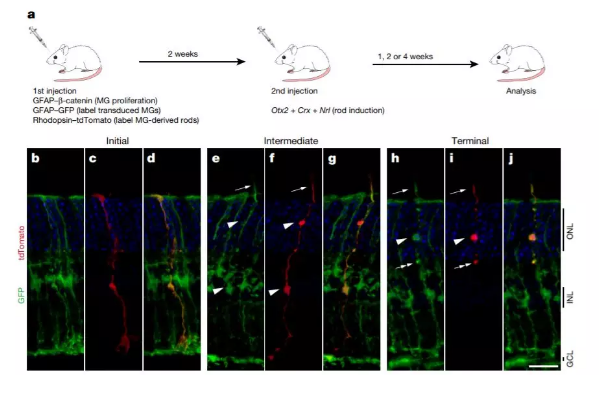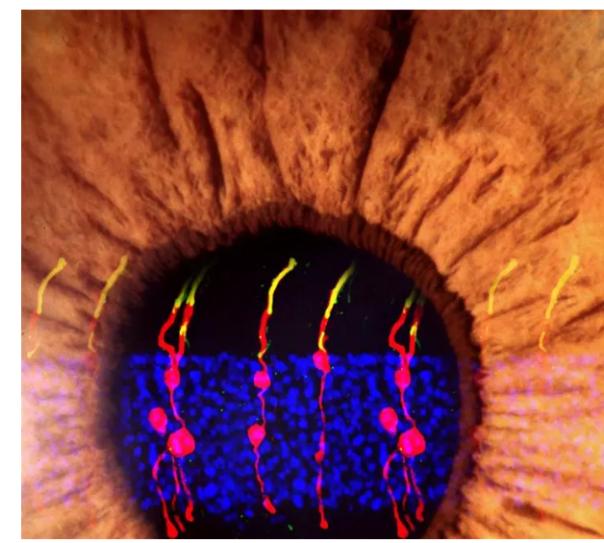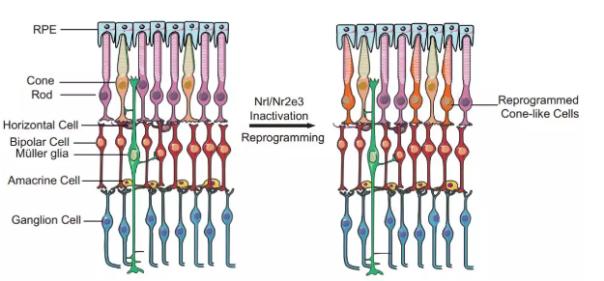Nature is heavy: Chinese scholars let congenital blind mice see the light for the first time
Nature is heavy: Chinese scholars let congenital blind mice see the light for the first time
August 16, 2018 Source: Academic Jingwei
Window._bd_share_config={ "common":{ "bdSnsKey":{ },"bdText":"","bdMini":"2","bdMiniList":false,"bdPic":"","bdStyle":" 0","bdSize":"16"},"share":{ }};with(document)0[(getElementsByTagName('head')[0]||body).appendChild(createElement('script')) .src='http://bdimg.share.baidu.com/static/api/js/share.js?v=89860593.js?cdnversion='+~(-new Date()/36e5)];Today, Nature published a heavy study of Chinese scholars. The team of Professor Bo Chen from the Icahn School of Medicine in Mount Sinai used regenerative therapy to make the mice suffering from congenital blindness see the light for the first time!
It is estimated that more than 50 million patients worldwide suffer from blindness, one of the main reasons being the deterioration of retinal neurons. In the zebrafish, many researchers have seen the hope of using regenerative therapy for eye diseases. After the eye injury, the Müller glia in these animal eyes will undergo "cell reprogramming" and become sensitive. Cells and other retinal neuronal cells. Therefore, even after experiencing very severe retinal damage, zebrafish can quickly restore vision.
But mammals are not zebrafish after all - human or mouse photoreceptor cells are difficult to regenerate once they die. In order to stimulate mammalian Müller glial cells, further damage to the retinal tissue must be performed.
"From a practical point of view, activation of Müller glial cells by injury to the retina is contrary to the goal of restoring retinal function," said Professor Bo Chen, the author of the study. "We want to know that without prejudice to the retina." Can you make Müller glial cells into light rod cells in mice?"

Graphic of this study (Source: Nature)
To test the feasibility of this idea, the researchers first experimented in normal mice. The experiment is divided into two steps. The first step is to activate the β-catenin protein by injecting a specific gene into the eye. A few weeks later, the researchers injected other key transcription factor genes into their eyes to promote rod cell production.
Under the microscope, the researchers clearly saw the newly formed rod cells. They do not appear to differ from the structure of ordinary cells. In addition, the researchers also observed the formation of new synapses, indicating that the newly generated cells may have the physiological functions of normal cells.

Müller glial cells successfully differentiate into rod cells (Source: Prof. Bo Chen)
Further research confirms this exciting view. The researchers used this regenerative therapy in mice with congenital blindness and observed the same results—they developed new rod cells in their eyes, and these cells can be used with retinal neurons. communication. More importantly, both the retinal ganglion cells and the brain analysis showed that these mice responded to light.
In other words, these blind mice were born for the first time in their lives.
"This is the first report of reprogramming Müller glial cells in mammalian retina to form functional rods," said Dr. Thomas N. Greenwell, director of the Retinal Neurology Program at the National Eye Institute. Rod cells not only allow us to see things in low light conditions, but also help protect cones, which are important for color recognition and HD vision, but cones tend to die in the later stages of eye disease. Cells can regenerate in the eye and may give us new strategies for treating eye diseases."
According to the plan, the research team will further evaluate whether these mice's vision can cope with some simple daily tasks (such as walking the maze). In addition, researchers will also try to test the feasibility of this regenerative therapy in human retinal tissue.

Researchers are experimenting with a variety of different techniques to overcome blinding eye diseases (Source: Precision Clinical Medicine)
It is worth mentioning that many research groups are currently trying similar methods, expecting to bring regenerative therapies for treating multiple eye diseases in mammals (Related reading: Bright in front! Zhang Kang team's top journals re-issued: Regenerative therapy can be Treating serious eye diseases). In a report earlier this year, we mentioned that the team of Professor Zhang Kang of the University of California, San Diego has tried to treat retinitis pigmentosa by cell reprogramming in a primate model. According to reports, the safety and effectiveness of the animal test are very positive, and it is expected to enter the clinical trial phase by the end of this year.
We expect that in the near future, regenerative therapies for the treatment of human eye diseases will come out as soon as possible, so that patients living in the dark can see the light again!
Reference materials:
[1] K Yao et al., (2018) Restoration of vision after de novo genesis of rod photoreceptors in mammalian retinas, Nature, DOI: https://doi.org/10.1038/s41586-018-0425-3
[2] NIH-funded researchers reverse congenital blindness in mice, Retrieved August 15, 2018, from https://
[3] Mount Sinai researchers discover how to restore vision using retinal stem cells, Retrieved August 15, 2018, from https://
[4] Lu Y and Zhang K, Cellular Reprogramming in the Retina — Seeing the Light. NEJM 2018
[5] Jorstad NL, Wilken MS, Grimes WN, et al. Stimulation of functional neuronal regeneration from Müller glia in adult mice. Nature 2017;548:103-7
[6] Zhu J, Ming C, Fu X, et al. Gene and mutation independent therapy via CRISPR-Cas9 mediated cellular reprogramming in rod photoreceptors. Cell Res 2017;27:830-3
Insert pad are a disposable product that can be easily changed without washing.Some of the super absorbent core layers are composed of polymer absorbers and villi.Absorb quickly and fully, effectively condense without infiltration, ensure anti-seepage and anti-leakage, make users dry and cool at any time.At the same time the use of leakproof elastic pants edge, unique U-shaped design, gently wrapped around the legs, effectively prevent urine leakage side, no matter what the circumstances are dry and clean.Arc draping, and considerate body.It also has soft, dry and non-woven fabric surface with good air permeability, which makes users feel comfortable and natural at any time.
Insert Pad,Disposable Insert,Attends Insert Pads,Diaper Liners
Shandong Kangshun Daily Products Co., Ltd , https://www.centurybenifit.com